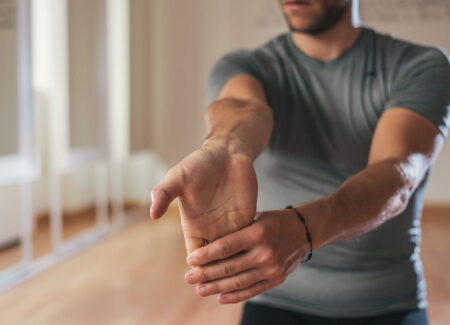Medically reviewed by Misty Seidenburg
Range of motion is how far you can move and extend a joint or muscle independently or with assistance. Injury or disease can affect range of motion. How we sit, stand, sleep, and perform other daily activities can also lead to decreased range of motion over time. But it is possible to move more freely and easily without pain.
Here are some safe and gentle range of motion exercises you can do at home to reduce stiffness and increase range of motion in different parts of the body.
Why Does Range of Motion Matter?
A joint is a part of the body where two or more bones come together. When a joint extends, the muscles, tendons, and connective tissues also lengthen and stretch. Range of motion (ROM) is how far these structures can move in any direction. When ROM is limited, your body’s functional mobility, or ability to move around your environment, is also restricted.
Simple everyday tasks like walking, standing, bending, or getting up and down from a chair can be difficult or painful depending on the body part affected. If you perform these tasks incorrectly (with poor form), your body overcompensates for this lack of mobility, causing musculoskeletal issues in other areas and increasing the risk of injury.
What Causes Limited Range of Motion?
There are many reasons why you may have limited mobility and ROM. Some are temporary, while others are associated with chronic conditions. These injuries and conditions can involve the muscles and joints and the tissues and structures that connect and support them.
Limited ROM can be caused by:
It’s worth highlighting the connection between aging and ROM changes because they affect everyone. As we age, we all experience specific physical changes that can impact ROM. Our muscles lose size and strength, and our joints become less flexible as the cartilage that cushions bones becomes thinner.
Lack of movement also contributes to ROM problems. Exercise is vital for seniors to combat these changes and restore ROM. Research shows seniors who move more are more flexible. Under the supervision of a physical therapist, older individuals who exercise and stretch can also increase muscle mass, improve balance and coordination, and slow the rate of bone loss.
Measuring Range of Motion
Difficulty with everyday activities is a common sign of ROM loss. For example, you might not be able to reach something on a high shelf or have knee pain when sitting and standing.
But physical therapists measure ROM a bit more precisely. They use a handheld tool called a goniometer to measure the angle at which you can move a specific joint. It’s used for nearly all joints except those in the spine. Physical therapists use an inclinometer for the back to assess how far you can bend forward from a standing position.
Active vs. Passive Range of Motion
Physical therapists measure three types of ROM:
- Active Range of ROM: This is when you only use your muscles unassisted to move a body part.
- Active-Assisted ROM: You can move an injured body part but may require some help due to pain or weakness.
- Passive Range of ROM: Another person or a machine manually moves your body while you are relaxed.
During your initial physical therapy evaluation, these measurements are recorded and used as a baseline to track your progress with each session.
In addition to physical therapy, you can do simple stretches and exercises at home to promote healthy ROM. These movements should not be painful. Move slowly and gently, and stop if you have any discomfort.
Neck Range of Motion
Poor posture from looking down at phones and other screens, awkward sleeping positions, and head, neck, and back injuries can affect neck ROM. Try these stretches to combat pain and stiffness from “tech neck” and other conditions.
Cervical Rotation
- Sit with your hands resting at your sides.
- Gently rotate the neck from side to side so you are looking over each shoulder. Go as far as comfortable before returning to the starting position.
- Do one set of 10 as needed throughout the day.
Cervical Lateral Flexion
- Sit up straight with chin tucked in slightly. Squeeze your shoulder blades together.
- Bend your neck to one side, bringing your ear as close to the shoulder as possible.
- Return to the starting position and repeat on the other side.
- Do one set of 10 as needed throughout the day.
Cervical Flexion With Chin Tuck
- Sit up with your chin tucked in slightly.
- With your chin tucked, slowly bend your head forward until you feel a stretch in the back of your neck.
- Hold for a few seconds and return to the starting position.
- Do one set of 10 as needed throughout the day.
Shoulder Range of Motion
Injuries and chronic conditions like arthritis and bursitis can limit shoulder mobility and make moving your shoulder and arm challenging. ROM loss is also common after shoulder or elbow surgery. You can do these on the affected shoulder or both sides to increase or maintain good ROM.
Shoulder Abduction Exercise
- Lie on the unaffected side.
- Extend the top arm and rest it on your hip with your thumb pointing toward the ceiling.
- Slowly lift your arm towards the ceiling, up and over your head into a full ROM.
- If you can keep moving until your arm touches your ear and your thumb points toward the ground.
- Return to the starting position and repeat 15 times.
Active Shoulder External Rotation (Lying)
- Lie on the unaffected side.
- Bend the top arm elbow to 90 degrees and rest it on the side of your body.
- Slowly move the forearm towards the ceiling and back down to your side, keeping your upper arm close to the body.
- Return to the starting position and repeat 15 times.
Wall Slide Stretch
- Stand up straight, facing a wall.
- Place your arms on the wall and slowly slide your hands and arms upward as you move your body closer to the wall.
- Hold the position for 3 seconds and slowly slide your arms down the wall to return to the starting position.
- Repeat 15 times.
Wrist Range of Motion
Wrist pain and ROM loss can happen from a sudden impact or long-term conditions like arthritis, repetitive stress, and carpal tunnel syndrome. Try these moves to stretch the wrist muscles and tendons and improve circulation and flexibility.
Fist Exercise
- Make a fist with your hands.
- Open your palms and slowly stretch your fingers out until fully extended.
- Repeat 10-15 times.
Wrist Extension and Flexion
- Rest your forearm on a desk or table with your hand hanging over the edge.
- Gently move your hand up until you feel a mild stretch.
- Return your hand to the starting position.
- Repeat 10-15 times.
Wrist Stretching Using Table
- Place both hands on a table with your palms facing down and fingers pointing away from you.
- With your elbows straight, gently lean your body forward.
- Hold for a few seconds and return to the starting position.
- Repeat 10-15 times.
Hip Range of Motion
Hip stiffness and pain can result from an injury, such as a fracture, dislocation, or chronic wear and tear. You might notice a limp or have trouble bending and sitting. Our hips are involved in nearly all movements, so ensuring they are healthy and flexible is essential.
Standing IT Band Stretch
- Stand up tall next to a wall for support.
- Cross the leg closest to the wall behind the other leg.
- Gradually lean toward the wall until you feel a stretch in your outer hip.
- Hold for 30 seconds. Do this 4 more times and repeat on the other side.
Knee to Chest
- Lie on your back with your legs extended in front of you.
- Bend one knee and grasp your shin with your hands.
- Gently pull the knee toward you as far as is comfortable.
- Hold for 30 seconds and release the bent knee to the ground.
- Hold for 30 seconds. Do this 4 more times and repeat on the other side.
Seated Rotation
- Sit on the floor with both legs extended in front of you.
- Cross one leg over the other as you gently twist toward the bent leg.
- Place the opposite arm over your bent thigh and use it to twist further.
- Look over your shoulder and hold for 30 seconds.
- Return to center. Do this 4 more times and repeat on the other side.
Knee Range of Motion
Healthy knees should support the body when you stand up straight and bend your leg past 90 degrees so your foot touches your glutes. It’s common to lose ROM with age. These exercises are ideal for improving and maintaining ROM in injured and healthy knees.
Seated Extension
- Sit with your leg outstretched in front of you and your heel resting on a chair.
- Hold this position for 3-5 minutes. Rest and repeat 2-3 times on each leg.
Seated Flexion
- Sit on the edge of a chair.
- Place the foot of the unaffected leg in front of the other foot.
- Gently push the front foot back as far as is comfortable.
- Hold for 10 seconds. Rest and repeat 2-3 times on each leg.
Heel Slides
- Remove your shoes and lie on your back with one leg extended straight.
- Bend one knee and gently slide it back as far as possible.
- Hold that position for 3-5 seconds and reverse it forward until your knee is straight.
- Repeat 2-3 times on each leg.
Ankle Range of Motion
Ankle sprains and chronic ankle instability are common causes of ankle pain and decreased ROM. These exercises will improve ankle strength, mobility, and flexibility to support your body and return to activity after an injury or surgery.
Ankle Alphabet
- Sit in a chair with your legs bent in front of you.
- While only moving your foot and ankle, “write” each letter of the alphabet.
- Try to avoid moving your hip or knee.
- The letters will start small and gradually become bigger as your ROM improves.
- Complete the alphabet and repeat on the other leg.
Towel Stretch
- Sit in a chair or on the floor with your legs in front of you.
- Hold both ends of a towel or exercise resistance band and loop it around the ball of the affected foot.
- Keeping the affected leg straight, pull the towel/band toward you.
- Hold this position for 30 seconds and release.
- Repeat up to 10 times on both sides.
Heel Cord Stretch
- Stand facing a wall with your unaffected leg in front. Bend it slightly at the knee.
- Straighten the affected leg behind you, keeping your heels flat, and your toes pointed in slightly.
- With both heels on the floor, lean your hips toward the wall.
- Hold this position for 30 seconds and release.
- Repeat up to 10 times on both sides.
Physical Therapy for Range of Motion
Physical therapy is effective for individuals of all ages and abilities, whether rehabbing from an injury or being proactive about maintaining healthy ROM. The exercises we’ve provided are just a glimpse of what’s possible when you work with a physical therapist.
Physical therapy helps patients with ROM challenges improve joint movement, function, and integrity. It also decreases pain and stiffness and prevents future injuries. Therapeutic exercise and stretching are good for balance and stability as well.
Are you ready to experience the benefits of physical therapy for yourself? Find a physical therapy clinic near you to schedule an evaluation today.

